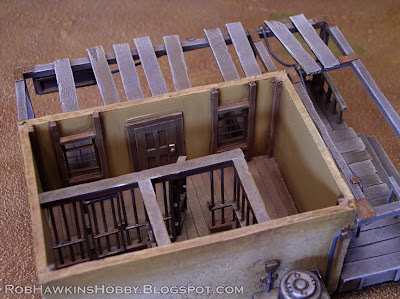(Sorry about the photo quality: our better camera conked out just as I
was about to take these, so I had to resort to the old one.)
Zombies are finally complete!
Part 1 of this tutorial covered modding figures to make 1/72 zombies,
part 2
covered actual painting, and this part will cover finishing touches,
including the "magic dip" method for adding outlines and shadows.
 |
| 1. The first step
is to finish the bases. I just paint them with a couple coats of flat
black paint. I don't like anything more detailed, preferring as neutral a
base as I can so I can feasibly use these figures for a number of
scenarios. If I added static grass, for example, they would look strange
in an indoor dungeoncrawl. |
 |
| 2. The eponymous
"dip" is this stuff: Minwax Polyshades, Classic Black Satin finish. It's
wood stain and finish in one. The figure is mounted here on a
battery-powered drill: this is another reason I glue my minis to nails
when painting. Some people prefer the control of painting the "dip" onto
their figures, but as I find one needs to wipe the dip off no matter
what, I like actually dunking the figures in the dip |
 |
| 3. I do this with
a box nearby and plenty of paper towels on hand. I open the can, dip
the mini while holding the drill, then immediately hold it over the box
and spin the drill, to shake off most of the excess dip. Be sure to do
this in a well-ventilated area, and to put the lid back on the can when
you aren't using it to minimize exposure to fumes. |
 |
| 4. After it's
dipped, you'll need to remove even more excess dip. Blowing on the mini
while it's in the box will get rid of the globs that tend to accumulate
between arms and legs, and a paper towel will soak any dip that pools in
the neck and other places. Dab if you want to reduce the amount of dip,
and wipe if you want to remove most of it. By the way, your minis
usually won't turn out this dark: I have a problem with too-thick dip
that I'll need to solve. |
 |
| 5. Give the dip
at least a full day to dry. Even with the satin finish instead of the
gloss, the dip looks way too shiny for most minis. A matte spray will
solve this problem, and will also provide another layer of protection.
Do this outside on a fairly warm day with fairly low humidity, and be
sure to rotate the figures and spray as much of them as you can. |
 |
| 6. Give the matte
around an hour to dry: You'll see that it kills the shine and also gets
rid of a lot of the blobbiness the dip leaves. At this point you can
simply pry the minis off the nail head, and they're mostly ready to go
(the nails are reusable). You may want to use a hobby knife or emory
board to get rid of any excess glue or paint that accumulated around the
nail head on the bottom of the miniature, so it will rest flat on the
table. |
I hope this tutorial was helpful to at least some of you. As I
mentioned, I'm concerned by how dark and splotchy the dip is leaving my
figures lately. It's a decent effect for zombies, but I used to get a
much cleaner look
from this method. I think the problem is that I was lazy about fully
sealing the can of dip when I was done with it, which allowed for a
degree of evaporation that has now left the dip too thick. I need to
figure out a way to thin it with something that won't eat my plastic
figures. I'd welcome any suggestions!



















































